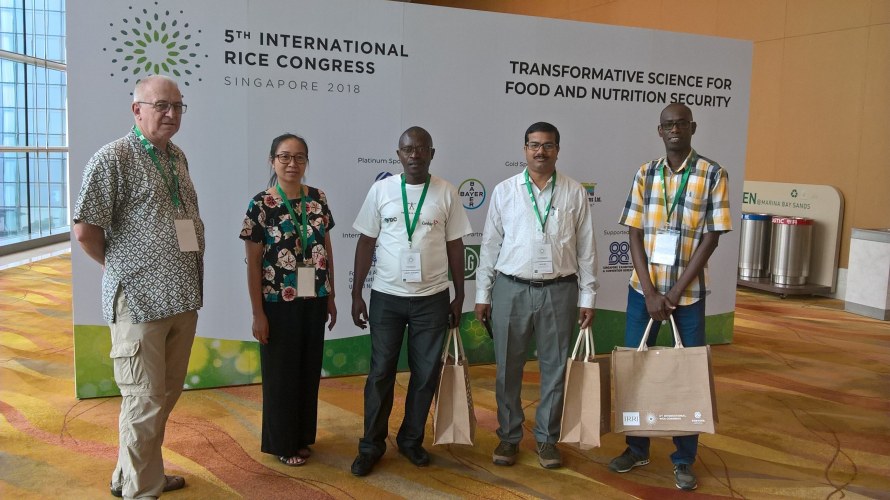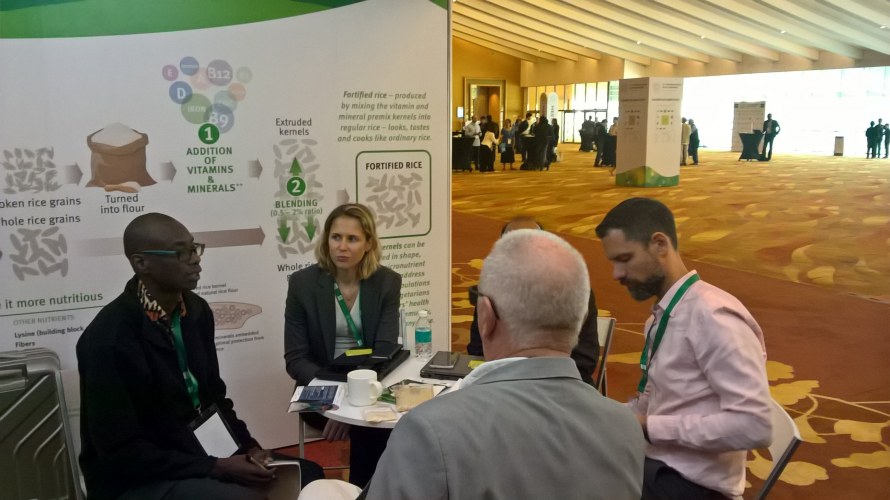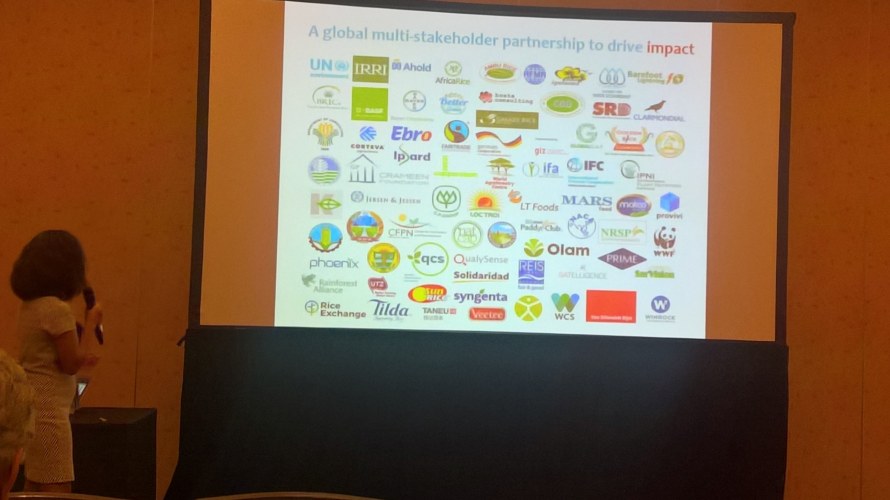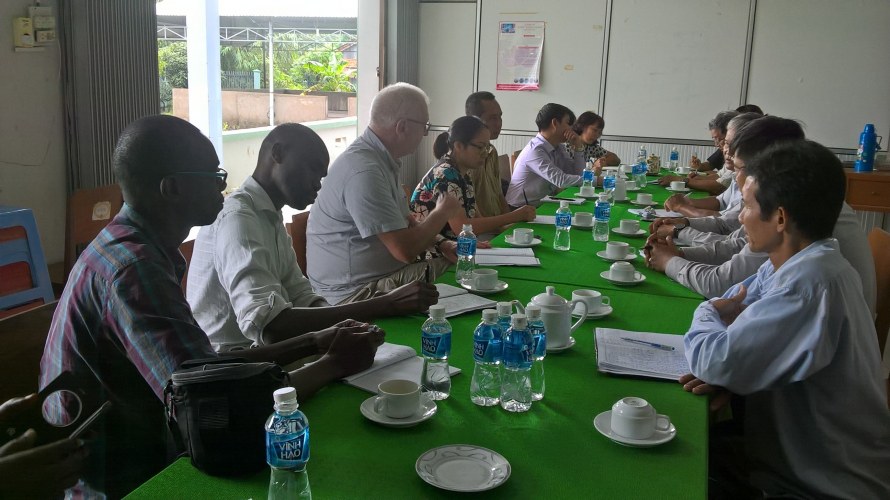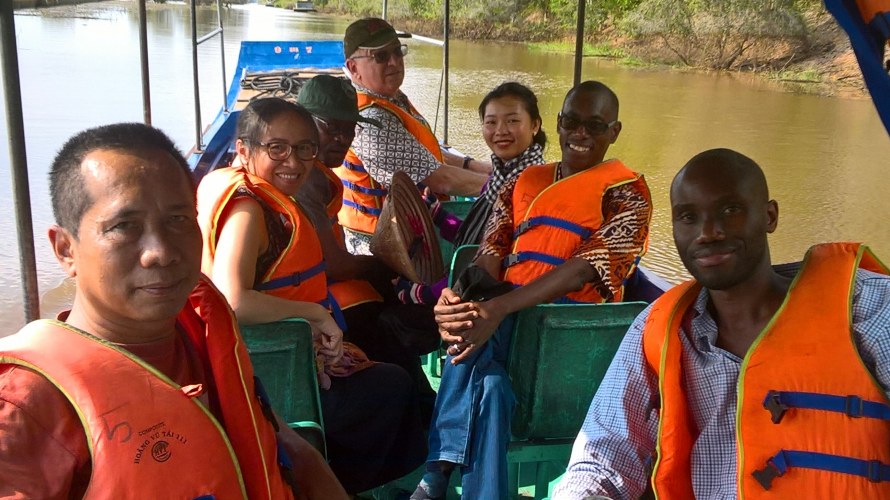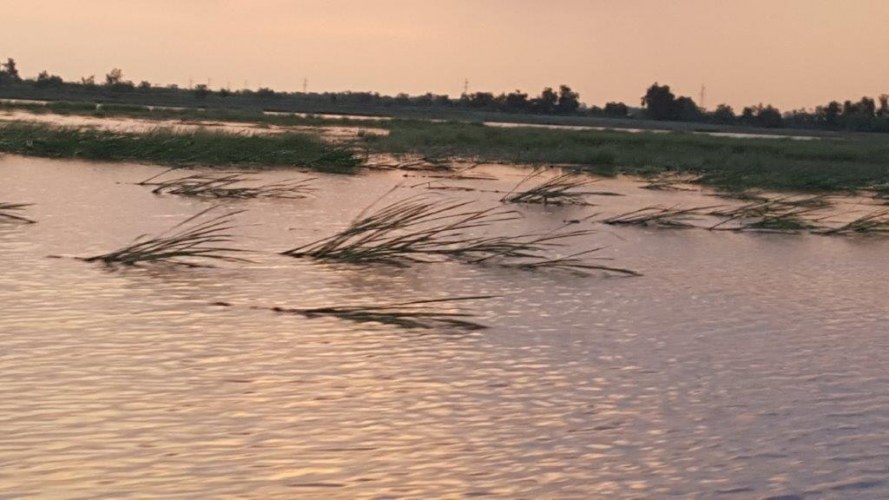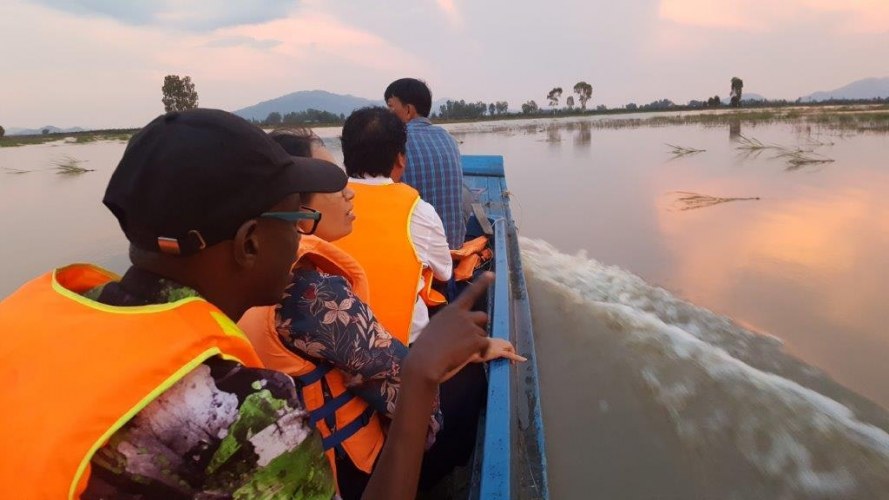Last October seven of our colleagues attended the 2018 International Rice Congress in Singapore, after which they headed off to Vietnam to find out all about Asian rice-growing. Mame Birame Ndiaye, Rikolto’s programme manager in Senegal, and Louis Tchuma, from Rikolto in the Democratic Republic of Congo, were among those who benefited from this first-hand approach. In this interview, they both highlight aspects that could be applied in Africa.
Making African rice competitive with Asian rice
Making African rice competitive with Asian rice
Mame: The International Rice Congress is the biggest conference on rice research, a strategic commodity that involves stakeholders at several levels to produce rice worldwide. To me, it was a very inspiring gathering.
Louis: Delegates came from all corners of the globe. We weren’t able to attend every session, because there were so many. In Asia, where the technology is very advanced, I saw a lot of techniques, many of which are not directly transferable to Africa. Some, such as the System of Rice Intensification, can be copied and are already applied in DRC.
Which approach or initiative developed by other participants to the conference can be replicated in your region? Which session inspired you most?
Mame: For me, it was the technology of rice fortification for improved nutrition. This kind of rice can be sold to schools and the army, i.e. in large institutional markets. In West Africa, we (Rikolto staff) always used to think that fortified rice was genetically modified (GMO) rice. But the conference helped us understand that micro-nutrients, i.e. vitamins, are added to the rice during processing. Rice fortification is already carried out in Mali and we should capitalise on it. Another inspiring session was the one organised by Rikolto in which Phoenix Commodities talked about working together according to the principles of the SRP (Sustainable Rice Platform) in Vietnam, which is an excellent initiative designed to improve the resilience of smallholders to climate change. This initiative requires the involvement of the private sector to promote the rice and its sustainability principles, which is a major problem in West Africa because of the lack of private investors.
Louis: Another thing for me was the gender approach. While it’s true that we’ve undertaken certain activities, such as female leadership training, as well as work on parboiled rice, in my experience it wasn’t enough to bring about change. We have to do much more. Together with women, especially the younger generation, I will now identify the challenges we need to work on so as to translate them into specific actions.
What initiatives will you incorporate in your current or future programmes?
Mame: We actually started putting the SRP principles into practice in 2018 through three pilot schemes in Benin, Mali and Senegal, involving an average of 240 producers per scheme. Our aim is to increase their resilience to climate change and improve their farming practices and market competitiveness. Another aspect of the SRP worth exploring is connecting up producers with the private sector (the supermarket chain Auchan, for instance).
With that in mind, we’re now discussing an effective, sustainable strategy to forge links between the producers in FEPROBA (Anambe Basin Producers’ Federation, in south-east Senegal) and Auchan in Senegal, which is increasingly specialising in selling locally sourced products. Starting in 2019, Rikolto will facilitate contact between Auchan and FEPROBA, which has some 4,500 members farming 5,000 ha of rice fields.
Regarding fortified rice, Rikolto’s partner organisations will focus on selling paddy rice to the processing units that make this rice. In other words, rice fortification will not be carried out by the farmers’ organisations.
Louis: Some very practical things inspired me. For example, GrainPro bags and other products help reduce food losses and improve food quality by protecting agricultural commodities against insect infestation, mould growth and rancidity. In the new areas where we will be working, we’re planning to work with GrainPro to facilitate storage immediately after harvest, pending sale. They offer weatherproof storage bags in all sizes, including mobile storage kits that can hold between 350 and 1,050 tonnes. There’s also equipment for weeding, planting, etc. A Bukavu engineer told me he can replicate all that locally from next year. For that, we’ll take into account the internal development of the technology.
After Singapore, you headed for Vietnam, where you took a look at the rice programmes. What do you particularly remember about that?
Louis: Rice is the main crop in Vietnam, along with vegetables. Almost all the fields grow rice and a large proportion of the country’s population work with it in some way. The value chain is highly organised from production to marketing. There are even processing companies that have established links with producers’ organisations that receive inputs from these companies, with payment made once the product is sold.
Mechanisation is very advanced throughout the value chain. There are some very large factories where everything is organised from the drying stage right through to loading the last consignments of rice onto the boat. Drying is done electrically and in some places rice husk briquettes are used as fuel to heat the paddy drying oven.
Floating rice is a variety that has never been seen elsewhere and is grown in flood conditions: planting is done from a canoe and there’s no need for weeding.
The cooperatives determine the member shares based on the area cultivated by each member. You can easily find farmers there who grow 50 ha, whereas 2 ha is the maximum over here. At cooperative level, the market is no longer a problem. The research centres are well equipped and have all the requisite facilities for germplasm conservation.
Mame: Floating rice, with roots two and a half metres long – that was a first for me! I’d only ever seen it in the SRP literature. In Vietnam, it’s the government that chooses the stakeholders or organisations with which to work. The NGOs do not choose the structures. We have more freedom in West Africa but to add weight and make it easier to scale up, it’s still important to involve government bodies in our activities.
Regarding the value chain approach, all the links are well represented in Vietnam. However, there’s a problem at production level: extensive use of pesticides and other chemicals. To give them access to the market, the cooperatives have two types of contracts: a model contract with a fixed purchase price and a second contract that follows price trends in the market. This model may provide a solution to contract non-compliance by producers in our country.
The factories are sited along the banks of canals to facilitate transportation of the product. This demonstrates once again the need for infrastructure to ensure value chain development.
Are there any aspects that can be replicated in Africa?
Mame: In discussions with colleagues in Vietnam, we learned that an internal quality control system is in place there. We’ve asked for documentation to enable us to replicate it in West Africa and other regions.
Louis: We’ll have to see if it’s possible to persuade the cooperatives to follow the example of their Vietnamese counterparts and determine member shares based on the area cultivated.
How can West African and Congolese rice be made competitive and what is Rikolto’s role in making this possible?
Mame: In Vietnam, production costs are low and productivity is high. They can produce an average of two times 6 tonnes per hectare per year. But they do use a lot of fertiliser. And pesticides, which obviously has an adverse impact on the environment and product quality.
So in our case, we have to look at how to control production costs: access to water, labour, inputs, techniques, etc. The SRP principles can help us to do this, especially in improving farming practices at a lower cost.
Louis: Mechanisation is required at each stage. Just transporting a 100 kg bag from the field to the factory by bike costs farmers $4 because you have to cross rivers in the Ruzizi Plain. The infrastructure also needs to be improved: new roads, bridges, storage facilities.
Have you already seen concrete positive change because of our intervention?
Louis: There has been real change in terms of quality. Mini-rice mills are producing rice that can compete with imported rice. On the seed front, we tested all the varieties available in our region. The producers were involved, but we also did tasting tests with the consumers. Now, the best varieties are about to be taken up in the national register by the National Agronomy Research Institute (INERA), which is needed to start multiplying.
Mame: Rikolto’s actions in West Africa have launched a process of professionalisation of farmers’ organisations, reflected in the improved quality of rice (paddy and parboiled). Producers and their organisations are already taking market requirements into account by adopting new parboiling techniques in Burkina Faso, with paddy rice production based on varieties demanded by consumers. This is the case with FEPROBA, which has opted for two varieties (Orylux 6 and Nerica L19) based on market demand. FEPROBA has become an approved certified seed supplier to the State. Burkina Faso also has institutional markets where female parboilers supply parboiled rice that meets the standards required by the State through SONAGESS.
Rikolto’s expertise continues to be recognised, demonstrated by the fact that the Burkina Faso government has elevated it to the rank of Knight of the National Order of Merit. The country’s parboiling centre was established by the government as a benchmark.

